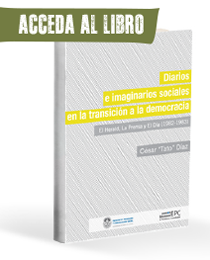The informative microformat in smartwatches
Case study of the app «RTVE Informativos 24 horas»
DOI:
https://doi.org/10.24215/24690457e043Keywords:
journalism, glance journalism, new narratives, smartwatchesAbstract
Technological development has influenced more mobile audiences with greater demand for new resources that allow them to communicate and be informed under this premise. Through the case study of Radio Televisión Española (RTVE)'s work, the authors analyze how the news microformat adapted to smart watches is developed, which at the moment is shown as not very innovative, without visual stimuli and with a strong dependence on the smartphone.
Downloads
References
Anguí-Sánchez, D., Cabezuelo-Lorenzo, F. y Sotelo-González, Jo. (2019). Innovación tecnológica y social en los nuevos medios digitales norteamericanos. Análisis del caso de Quartz News. Revista Latina de Comunicación Social, (74), 1697-1713. https://doi.org/10.4185/RLCS-2019-1405
Benítez de Gracia, M. J. y Herrera Damas, S. (2018). Los primeros pasos del reportaje inmersivo a través de vídeos en 360º. Historia y Comunicación Social, 23(2), 547-566. http://dx.doi.org/10.5209/HICS.62784
Bradshaw, P. (2017). The Online Journalism Handbook. Skills to Survive and Thrive in the Digital Age. Birmingham, England: Routledge.
Carlan, S. (2019). Jornalismo ubíquo para smartphones: proposta de instrumento de análise de propiedades técnicas. En J. Canavilhas, C. Rodrigues, y F. Giacomelli
(Eds.), Narrativas jornalísticas para dispositivos móveis (pp. 57-76). Covilha, Portugal: Labcom.IFP.
Casero-Ripollés, A. (2020). Impact of Covid-19 on the Media System. Communicative and Democratic Consequences of News Consumption during the Outbreak. El profesional de la información, 29(2), e290223. https://doi.org/10.3145/epi.2020.mar.23
Castellet, A., Aguado, J. M. y Martínez, I. (2013). Los nuevos actores que cambian las reglas y el juego. Cómo Apple y Google han transformado la distribución de contenidos. En K. Zilles, J. Cuenca y J. Rom (Coords.), Breaking the Media Value Chain. VII International Conference on Communication and Reality (pp. 333-342). Recuperado de https://bit.ly/3BECkbz
De Sousa, M. E. (2017). Notícias no pulso: Uma análise de aplicativos jornalísticos em relógios inteligentes. Revista Observatório, 3(1), 457-479. https://doi.org/10.20873/uft.2447-4266.2017v3n1p457
Ditrendia (2019). Mobile en España y el mundo 2019 [Informe]. Recuperado de https://mktefa.ditrendia.es/informe-mobile-2019
Ellul, J. (1986). La palabra humillada. Madrid, España: General Tabanera.
Fernández, R. (2020). Cuota de mercado mundial de los fabricantes de smartwatches 2017-2019. Statista. Recuperado de http://bit.ly/3rsJ6Mh
Giddens, A. (2003). Runaway World. How Globalisation is Reshaping Our Lives. New York, United States: Routledge.
Gutiérrez, B., Pérez, S. y López, X. (2020). Las secciones y Apps de RV y vídeos en 360º a examen. Estudio de caso de siete medios con impacto en Europa. Revista Latina de Comunicación Social, (75), 149-167. https://www.doi.org/10.4185/RLCS-2020-1420
Herranz, J. M., Sidorenko, P. y Cantero, J. I. (2019). Realidad virtual y periodismo inmersivo: nuevas formas de contar historias para los periodistas. En M. J. Ufarte
(Coord.), Nuevos perfiles profesionales para el mercado periodístico (pp. 127-148). Salamanca, España: Comunicación Social.
Hill, S. y Bradshaw, P. (2019). Mobile-first Journalism. London, England: Routledge.
Hjelm, J. (2000). Designing Wireless Information Services. Boston, United States: John Wiley & Sons.
Hootsuite y We Are Social (2020). Digital 2020. Global Digital Overview. Recuperado de https://bit.ly/30xbLDe
IAB Spain (2020). Estudio de Redes Sociales 2020. Recuperado de https://bit.ly/2DYfTF6
Jung, Y., Seongcheol, K. y Choi, B. (2016). Consumer Valuation of the Wearables. The Case of Smartwatches. Computers in Human Behavior, (63), 899-905. https://doi.org/10.1016/j.chb.2016.06.040
Jackson, W. (2019). SmartWatch Design Fundamentals. WatchFace Design for Samsung Galaxy SmartWatches. Berkeley, United States: University of California.
Jones, K. (7 de abril de 2020). How COVID-19 Has Impacted Media Consumption, by Generation. Visual Capitalist. Recuperado de https://www.visualcapitalist.com/media-consumption-covid-19/
Marshall, S. (5 de octubre de 2014). Glance Journalism: News without a Click [Entrada de blog]. Recuperado de https://bit.ly/32Mb2RF
Molyneux, L. (2018). Mobile News Consumption. A Habit of Snacking. Digital Journalism, 6(5), 634-650.
Narin, B. (2018). Less is More or Less is Biased: Glance Journalism [Conference]. In 16th International Symposium Communication in the Millennium (92-99). Association of Turkish and American Communication Scholars.
Nee, R. (2013). Creative Destruction: an Exploratory Study of How Digitally Native News Nonprofits are Innovating Online Journalism Practices. International Journal on Media Management, 15(1), 3-22.
Newman, N., Fletcher, R., Schulz, A., Simge, A. y Nielsen, R. K. (2020). Reuters Institute. Digital News Report 2020. Recuperado de https://bit.ly/3fVeIUD
Paíno, A. y Rodríguez, M. I. (2019). Propuesta de «géneros periodísticos inmersivos» basados en la realidad virtual y el vídeo 360. Revista Latina de Comunicación Social, (74), 1132-1153. http://dx.doi.org/10.4185/RLCS-2019-1375
Salaverría, R. (16 de enero de 2018). Allá donde estés habrá noticias. Cuadernos de periodistas, (35), 15-22. Recuperado de https://www.cuadernosdeperiodistas.com/alladonde-estes-habra-noticias/
Serrano, P. (2017). La transformación digital de una redacción y el periodismo móvil (MOJO). Barcelona, España: UOC.
Sidorenko, P., Herranz, J. M. y Cantero, J. I. (2020). Use of New Narratives for COVID-19 Reporting. From 360º Videos to Ephemeral Tiktok Videos in Online Media. Trípodos, 1(47), 105-122. https://doi.org/10.51698/tripodos.2020.47p105-122
Silva, A., López, X. y Toural, C. (2017a). A Review of Mobile Journalism in Spain. En Á. Rocha y otros (Eds.), Recent Advances in Information Systems and Technology,
Advances in Intelligent Systems and Computing 571 (pp. 93-100). New York, United States: Springer.
Silva, A., López, X. y Toural, C. (2017b). Los iWatch: el intenso flujo de microformatos de «periodismo de un vistazo» alimentan seis de los principales medios online. Revista Latina de Comunicación Social, (72), 186-196. http://dx.doi.org/10.4185/RLCS-2017-1160
Urry, J. (2000). Sociology beyond Societies. Mobilities for the Twenty-first Century. New York, United States: Routledge.
Westlund, O. (2012). Mobile News. A Review and Model of Journalism in an Age of Mobile Media. Digital journalism, 1(1), 6-26. Recuperado de https://www.tandfonline.com/doi/full/10.1080/21670811.2012.740273
Additional Files
Published
How to Cite
Issue
Section
License
Copyright (c) 2021 Pavel Sidorenko Bautista, Pablo Garrido Pintado

This work is licensed under a Creative Commons Attribution-NonCommercial-ShareAlike 4.0 International License.
The acceptance of an original by the journal implies the non-exclusive transfer of the patrimonial rights of the authors in favor of the publisher, who allows the reuse, after its edition (postprint), under a Creative Commons License Attribution-NonCommercial-ShareAlike 4.0 International.
According to these terms, the material can be shared (copy and redistribute in any medium or format) and adapted (remix, transform and create another work from the material), provided that a) the authorship and the original source of their publication (magazine and URL of the work) are cited, b) is not used for commercial purposes and c) the same terms of the license are maintained.
The assignment of non-exclusive rights implies that after postprint in IMPRONTAS de la historia y la comunicación authors may publish their work in any language, media and format; in that case, it is requested that they signal that the material was originally published by this journal.
Assignment also entails the authors’ authorization for the work to be collected by SEDICI, the institutional repository of the Universidad Nacional de La Plata, and for it to be indexed in the databases that the publisher thinks appropriate for enhancing the visibility of the published work and its authors.
In addition, the journal encourages authors to submit their works to other institutional and thematic repositories after their publication in IMPRONTAS de la historia y la comunicación, under the assumption that offering society unrestricted access to scientific and academic production contributes to a greater exchange in global knowledge.






.jpg)


.png)


.png)


















